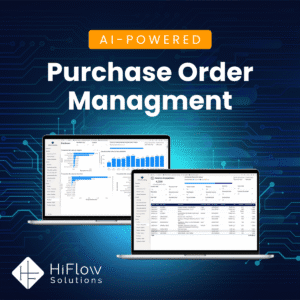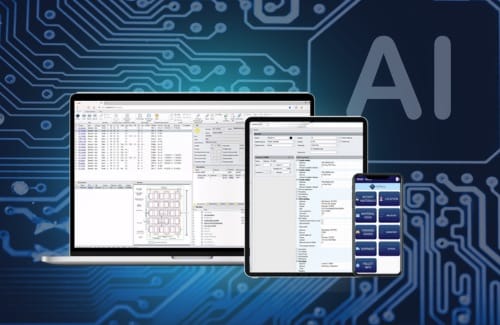CEOs in the packaging industry are increasingly asking: ‘Do we need a strategy that leverages AI?’
Executives in packaging and label converting now face a singular reality: growth and margin pressures demand more than incremental improvement. Labor constraints, supply chain volatility, and buyer expectations for speed and customization make it challenging for legacy ERP systems. The next wave of competitive differentiation lies in embedding AI natively within ERP/MIS systems — not as a bolt-on, but as a core enabler.
Recent research underscores this shift. The latest report from NAPCO Research notes that over 85% of print/packaging respondents consider AI critical to competitiveness, and more are applying it to estimating, workflow automation, and prepress. Combine this with broader industry reporting that AI use in operations and procurement is accelerating, and the imperative becomes clear: if your ERP isn’t AI-native, you risk falling behind.
Where does implementing AI make sense?
AI in Estimating: Smarter Quotes, Less Manual Work
Modern AI estimating systems don’t simply mimic spreadsheets. They evaluate the best manufacturing path based on product attributes, and account for process constraints. In cases where input data is incomplete, the system supports direct communication with the customer to obtain the missing information All estimates conform to your plant’s standards and capabilities. The outcomes: faster quoting, fewer errors, and consistent margin safeguards.
 AI in PO Processing: Orders That Process Themselves
AI in PO Processing: Orders That Process Themselves
In this module, AI ingests purchase orders from emails or PDFs, validates them against your definitions and rules, computes corrections, and imports the data automatically you’re your production cycle. That eliminates manual entry, shortens lead times, and catches discrepancies before they become delays.
AI in Supplier Delivery & Price List Automation
AI in the system interprets and matches items from supplier data with internal product codes, ensuring seamless integration into the company’s purchasing and cost calculation processes. It identifies price deviations, and missing data. AI handles validation and matching behind the scenes, giving you near real-time visibility into inbound logistics and cost updates.
AI in Logistics & Invoicing
From BOLs to accounts payable, AI can parse documents, split them, extract key fields, and link them back to POs and shipments. Rather than waiting for staff to reconcile invoices, your system completes the process automatically — reducing cycle times and improving accuracy.
Why C-suite should care
- Operational leverage: Every minute saved on manual tasks frees your team to focus on strategy, customer experience, or continuous improvement.
 Margin protection: AI-driven validation and consistency guard against costly errors, overrun jobs, and margin bleed.
Margin protection: AI-driven validation and consistency guard against costly errors, overrun jobs, and margin bleed.- Accelerated ROI: Investments in AI features yield returns quickly — especially in areas subject to repetitive manual work.
- Future-readiness: As AI adoption spreads (across estimating, scheduling, supply chain), firms with embedded AI will set the competitive baseline.
However, adoption still faces obstacles. According to NAPCO research, many firms cite organizational resistance, insufficient skillsets, and unclear ROI as top inhibitors. To succeed, leaders must pair AI rollouts with change management, data governance, and clear performance metrics. End-to-end support from a trusted ERP vendor will reduce risk, speed adoption, and ensure a smooth path to go-live.
Your Roadmap Forward: An AI Implementation Plan
 Audit your current processes for bottlenecks that are low-hanging opportunities.
Audit your current processes for bottlenecks that are low-hanging opportunities.- Prioritize AI modules (e.g. PO processing, estimating) that deliver fast payback.
- Deploy incrementally with guardrails, letting staff see wins early. Work with a vendor who prioritizes communication during implementation.
- Embed governance and user training so AI becomes trusted, not feared.
- Plan for extensibility —AI features not only automate a process but build the data foundation for future analytics capabilities.
To conclude, AI in ERP is no longer optional—it’s essential infrastructure. Leaders who treat it as a strategic investment instead of a novelty will capture new margins, defend market position, and scale with confidence. The future of packaging will not be defined by products alone—it will be defined by how intelligently your enterprise operates.
AI-Powered HiFlow ERP for Print & Packaging Converters
HiFlow ERP/MIS can deliver on the promise of AI. From AI-powered estimating that accelerates quoting, to purchase order automation that eliminates bottlenecks, to supplier processing that reduces costs and errors—HiFlow’s AI modules show how intelligence built into workflows produces measurable savings, sharper decision-making, and greater agility. For packaging manufacturers facing tariffs, labor shortages, and relentless competition, HiFlow’s AI-powered ERP is not just a system upgrade—it’s a pathway to sustainable growth and future-proof operations.
Additional articles you might find valuable
Bridging the Gap: Leveraging an ERP/MIS to Mitigate Skilled Labor Shortages
SUMMARY The skilled labor shortage has become a significant challenge across various industries, with sectors like manufacturing, logistics, and packaging feeling the impact most acutely. As the demand for skilled labor continues to outpace supply, organizations are...
Shop Floor Scheduling: Are You Getting the Most out of Your Plant’s Production Capacity?
SUMMARY Summary: SEMrush data from 2024 shows that companies integrating advanced scheduling technologies experience a 25% increase in production efficiency. Getting the most out of your plant’s capacity means implementing a robust ERP that helps plan, execute, and...
Seeing is Believing: Exploring HiFlow’s Highly Visual Workflow
SUMMARY Sometimes it can be difficult to quickly get to a full 360-degree view of the converter’s operation, including both production and business elements. That’s why HiFlow developers have placed a strong focus on developing a highly visual representation of a...

 Margin protection: AI-driven validation and consistency guard against costly errors, overrun jobs, and margin bleed.
Margin protection: AI-driven validation and consistency guard against costly errors, overrun jobs, and margin bleed. Audit your current processes for bottlenecks that are low-hanging opportunities.
Audit your current processes for bottlenecks that are low-hanging opportunities.

